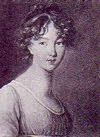The stockings, first of all, show how a pair that might have
the foot or parts of it worn out, could have a new foot knit onto it or just
parts of the foot replaced. I used different colours of wool to show that, in
the passage of time, the stockings’ original wool might not still be in the
knitter’s possession, and to illustrate the different parts of the foot. The
heel, especially, stands out since this is a major point of discussion in the
history of stockings. I also wanted to draw attention to the drawstring toes,
which are easier to see in these two shades of yellow than most of the other
stockings I have made in darker colours.
The completely re-footed stocking had its foot knit with a
slightly larger needle which, in a demonstration, will lead to the discussion
of 18th century needles, what they were made of, and their
non-standard sizes.
The stockings were knit on 2.75mm/2 US and
-->
3mm/2 ½ US double pointed needles with Harrisville Designs Shetland wool (which I just adore working with) in Zinnia, Marigold and Mustard. They have several purl rows at the welt and the seam/purl stitch down the back of the legs.




3 comments:
Very clear. I once knitted a test sock with a different color for each increase or decrease row, to emphasize the shaping as well.
Where are they going to be shown and discussed?
Hi, I had a question about an old post you did in 2008, dying to know the answer!
Was regarding the muffatee patterns in the Workwoman's Guide, I'm not 100% sure I've interpreted the first pattern correctly. From the description a "turn stitch" is purling? And the resultant piece ends up a fluted rectangle that is then sewn up the side?
Sorry to be a pest, I'm 1/2 way thru my first one and it's going to be pretty but I'm not sure if it's actually right.
Thank you!
Apologies, ladies, for not replying sooner. I have been away from this blog for a few weeks.
The stockings will be added to my collection of historical knitted and stitched objects that I use at living history and sheep and wool demonstrations and events.
As for the muffatees - their pattern is from Exercises in Knitting by Cornelia Mee. A turn stitch is indeed purling. The muffatee is knit in the round and the lines of the pattern result in columns at an angle. I added two rows of purl stitches to the top and bottom of each to give it more structure. I hope that helps - if not, ask again!
Post a Comment